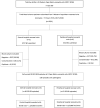Early onset neonatal bloodstream infections in South African hospitals
- PMID: 39833703
- PMCID: PMC11744941
- DOI: 10.1186/s12879-024-10406-z
Early onset neonatal bloodstream infections in South African hospitals
Abstract
Background: Neonatal sepsis is a leading cause of death in low- and middle- income countries (LMIC). Increasing antibiotic resistance in early onset (< 72 h of life) bloodstream infection (EO-BSI) pathogens in LMIC has reduced the effectiveness of the recommended empiric antibiotic regimen (ampicillin plus gentamicin).
Methods: We retrospectively analysed blood culture-confirmed EO-BSI episodes at nine neonatal units from three central and six peripheral hospitals in the Western Cape Province, South Africa between 1 January 2017 and 31 December 2018. Clinical and electronic laboratory records were reviewed to determine pathogen profile, empiric antibiotic coverage rates and factors associated with EO-BSI attributable mortality, stratified by hospital type.
Results: Of the 8252 blood culture specimens submitted for the investigation of suspected EO-BSI, 136 EO-BSI episodes yielding 141 pathogens were identified with an EO-BSI rate of 1.3 and 0.5 episodes/1000 live births at central and peripheral hospitals respectively. Preterm (93/136; 68.3%) and low birth weight (84/136; 61.8%) neonates were most affected. The predominant pathogens were Streptococcus agalactiae (46/136; 34%), Klebsiella pneumoniae (17/136; 13%), Listeria monocytogenes (11/136; 8%), Acinetobacter baumannii (11/136; 8%) and Escherichia coli (11/136; 8%). The empiric antibiotic (ampicillin plus gentamicin) coverage rate was 64% (95% CI 51-74) at central hospitals and 84% (95% CI 74-94) at peripheral hospitals. Neonates with Gram-negative EO-BSI and discordant empiric antibiotic therapy had almost four-fold and three-fold higher odds of death respectively.
Conclusion: Preterm and low birth weight neonates are most vulnerable to EO-BSI and have higher odds of death with Gram-negative pathogens and discordant empiric antibiotic therapy.
Keywords: Antimicrobial resistance; Early onset bloodstream infection; Empiric antibiotic; Neonate; Sepsis.
© 2024. The Author(s).
Conflict of interest statement
Declarations. Conflict of interest: The authors have no conflicts of interest to declare. Ethical approval: A waiver of individual informed consent was granted for this study. The Stellenbosch University Health Research Ethics Committee and the Tygerberg Hospital management reviewed and approved the study protocol SU HREC approvals N18/07/068, N20/07/070, in accordance with the Declaration of Helsinki. Funding: A.D. was supported by a NIH Fogarty Emerging Global Leader Award K43 TW010682. The WISCA analysis was supported by a grant to AD from the Science for Africa Foundation through a Data Science for Maternal Neonatal and Child Health Gates Grand Challenges grant. LB: This work is based on research supported by the South African National Research Foundation (NRF). Any opinion, finding, and conclusion or recommendation expressed in this material is that of the authors and the NRF does not accept any liability in this regard.
Figures



Similar articles
-
Epidemiology of healthcare-associated bloodstream infection in South African neonatal units.BMC Infect Dis. 2024 Nov 26;24(1):1350. doi: 10.1186/s12879-024-10219-0. BMC Infect Dis. 2024. PMID: 39593003 Free PMC article.
-
Neonatal bloodstream infections in a Ghanaian Tertiary Hospital: Are the current antibiotic recommendations adequate?BMC Infect Dis. 2016 Oct 24;16(1):598. doi: 10.1186/s12879-016-1913-4. BMC Infect Dis. 2016. PMID: 27776490 Free PMC article.
-
Pathogen aetiology and risk factors for death among neonates with bloodstream infections at lower-tier South African hospitals: a cross-sectional study.Lancet Microbe. 2025 May;6(5):100989. doi: 10.1016/j.lanmic.2024.100989. Epub 2025 Feb 25. Lancet Microbe. 2025. PMID: 40020700 Free PMC article.
-
Literature review on the distribution characteristics and antimicrobial resistance of bacterial pathogens in neonatal sepsis.J Matern Fetal Neonatal Med. 2022 Mar;35(5):861-870. doi: 10.1080/14767058.2020.1732342. Epub 2020 Feb 26. J Matern Fetal Neonatal Med. 2022. PMID: 32102584 Review.
-
Management of neonates at risk of early onset sepsis: a probability-based approach and recent literature appraisal : Update of the Swiss national guideline of the Swiss Society of Neonatology and the Pediatric Infectious Disease Group Switzerland.Eur J Pediatr. 2024 Dec;183(12):5517-5529. doi: 10.1007/s00431-024-05811-0. Epub 2024 Oct 17. Eur J Pediatr. 2024. PMID: 39417838 Free PMC article. Review.
References
-
- Dramowski A, Velaphi S, Reubenson G, Bekker A, Perovic O, Finlayson H, et al. National neonatal Sepsis Task Force launch: supporting infection prevention and surveillance, outbreak investigation and antimicrobial stewardship in neonatal units in South Africa. South Afr Med J. 2020;110(5):360–3. - PubMed
-
- Zingg W, Hopkins S, Gayet-Ageron A, Holmes A, Sharland M, Suetens C, et al. Health care-associated infections in neonates, children, and adolescents: an analysis of paediatric data from the European Centre for Disease Prevention and Control point prevalence survey. Lancet Infect Dis. 2017;17(4):381–9. - PubMed
-
- Arowosegbe AO, Ojo DA, Dedeke IO, Shittu OB, Akingbade OA. Neonatal sepsis in a Nigerian Tertiary Hospital: clinical features, clinical outcome, aetiology and antibiotic susceptibility pattern. S Afr J Infect Dis. 2017;32:127–31.
MeSH terms
Substances
Grants and funding
LinkOut - more resources
Full Text Sources

